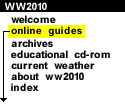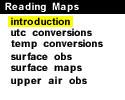
|

"Look for hazy skies with afternoon thunderstorms and a high of 95 degrees." Weather forecasts, such as this one, provide critical information to many people, including farmers, construction workers, and those planning a trip to the beach. In severe weather situations, short-term forecasts and warnings can help save lives and protect property. But how does one take the wealth of weather information that is available and make a prediction from it?
In the sections that follow, we examine features to look for on weather maps to make a forecasts, general methods of preparing a forecast, and more specific tips for specific scenarios.
|
Sections
Last Update: 2/26/99 |
Coordinated Universal Time
Learn to convert your local time to the standard used by all meteorologists.
Temperatures
Surface Observations
Surface Maps
Upper Air Observations
|

Image Interpretation |
|

UTC Conversions |


